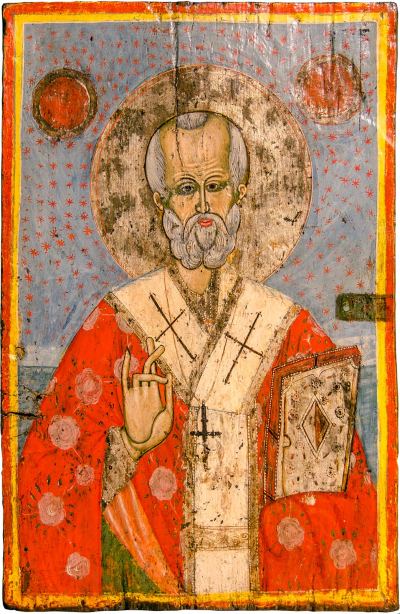- Name of the item: Icon from the Church of the Holy Mother of God from the village of Velushina, a presentation of St. Nicholas
- Period / dating: mid-19th century
- Origin: Church of the Holy Mother of God located in the village Velushina Bitola
- Material/technique: wooden base of an old nut tree painted with tempered colors
- Dimensions: 60 x 46 cm
Short story (description):
 Portrait of St. Nicholas. The saint is painted in the middle of the picture – the icon. It is painted to the upper half of the body. Around the head, there is an aureole made of silver, embellished with relief decorations. His head is painted with a high forehead, thin gray hair, thin facial features, half-length gray beard, waved around his face. The saint has a slim neck, around which a chiton is enwrapped. Actually, it is something in the shape of a scarf, white rectangular, set in the form of the Latin letter V, three thin crosses of different size were painted on it. His right hand, our left side, is painted with a clipped middle finger with his thumb – a blessing and symbol of Jesus. And with his left hand, which is not seen, he holds an upright book, written in a manuscript – Bible. He is dressed in formal attire with thin and elegant folds. In the upper left part of the icon there is a circle on which are decorative letters SV and on the right part also in a circular shape, stylized is written his name Nikola.
Portrait of St. Nicholas. The saint is painted in the middle of the picture – the icon. It is painted to the upper half of the body. Around the head, there is an aureole made of silver, embellished with relief decorations. His head is painted with a high forehead, thin gray hair, thin facial features, half-length gray beard, waved around his face. The saint has a slim neck, around which a chiton is enwrapped. Actually, it is something in the shape of a scarf, white rectangular, set in the form of the Latin letter V, three thin crosses of different size were painted on it. His right hand, our left side, is painted with a clipped middle finger with his thumb – a blessing and symbol of Jesus. And with his left hand, which is not seen, he holds an upright book, written in a manuscript – Bible. He is dressed in formal attire with thin and elegant folds. In the upper left part of the icon there is a circle on which are decorative letters SV and on the right part also in a circular shape, stylized is written his name Nikola.
This anonymous painter worked in the style of Byzantine art – which means – a precise drawing, an elongated spiritual body, lines that are sleek and richly applied, precisely and accurately. The icon is from the church Holy Mother of God, in the village of Velushina, near Bitola. It is masterly made, and those minimal lines expressed the maximum significance of the saint. The icon is now placed in the museum of icons in the Institute and Museum of Bitola and is part of a rich collection of icons from the same church that are displayed in the premises of the permanent exhibition.





You must be logged in to post a comment.